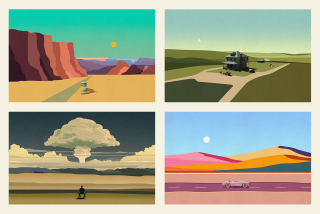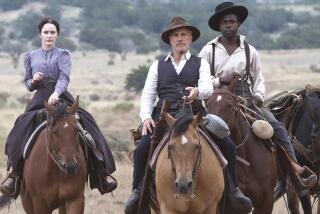A timeless ‘3:10 to Yuma’
- Share via
Like much else in popular culture, westerns changed radically after World War II. The sagebrush sagas became darker and grittier, and the days of the hero in the white hat and the villain in black gave way to various shades of gray. Heroes were so troubled they often seemed more like the bad guy while the bad guys were often charming, cunning, emotionally complex and even sympathetic.
John Ford delved into the darker side of the Wild West in such classics as 1946’s “My Darling Clementine,” 1948’s “Fort Apache” and, most notably, his 1956 masterwork, “The Searchers.” Anthony Mann, who cut his directorial teeth with several terrifically taut film noirs in the late 1940s, paired up with James Stewart for a series of hard-nosed westerns including “Winchester 73” and “The Naked Spur.” And then there were the psychologically daunting westerns Budd Boetitcher made with aging action star Randolph Scott, including his landmark “Seven Men From Now.”
Into that stable rides 1957’s “3:10 to Yuma.” This tense drama of redemption and self-worth arrives Tuesday on DVD, less than two weeks before the much ballyhooed remake with Christian Bale and Russell Crowe.
A young Elmore Leonard wrote the short story “3:10 to Yuma,” which was published in the March 1953 edition of the Dime Western pulp magazine -- he later said he was paid $90. Columbia quickly snapped up the rights to the tale, but it took four years to bring it to the screen.
The film was directed by Delmar Daves, who began his movie career as an 11-year-old actor in a 1915 version of “A Christmas Carol.” Though he made every type of film imaginable, from war thrillers such as “Destination Tokyo” to tawdry soap operas (“A Summer Place”), Daves did his best work on westerns: “Yuma,” 1950’s “Broken Arrow” and 1959’s “The Hanging Tree.”
Daves, working with a script by Halsted Welles, who also penned “Hanging Tree,” shows in “3:10 to Yuma” why he was a master craftsman. Though most westerns of the era were being shot in color, Daves opts for black and white, which emphasizes the desolation and isolation of the area and the lives of its inhabitants.
The film was beautifully shot in Arizona and at the old Warner Bros/Columbia Ranch in Burbank by Charles “Bud” Lawton, a veteran of the genre, having helmed “Jubal,” “The Tall T,” “Cowboy” and two of Boetticher’s classics, “Ride Lonesome” and “Comanche Station.”
Daves also elicits flawless performances from his two leads, Oscar-winner Van Heflin (a supporting actor nod for 1943’s “Johnny Eager”) and Glenn Ford, as the hero and villain, respectively, of the piece.
Heflin’s Dan Evans is cut from the same cloth as the everyman husband and father he essayed in 1953’s “Shane.” Evans is a regular guy with a loving wife and two young sons who isn’t willing to take many chances in life until he realizes he’s going to lose his homestead due to a lengthy drought.
He decides to risk everything when he’s offered $200 to take Ben Wade (Ford), the captured leader of a notorious gang, to a nearby town and make sure he gets the prisoner on the 3:10 p.m. train to Yuma so he can stand trial. The majority of the action unfolds not on the trail but in the small hotel room where Evans and Wade wait for the train.
The film turns into a verbal cat-and-mouse game between the two as the charming, soft-spoken killer Wade promises Evans a substantial amount of money to let him go. He charms Evans; he goads Evans; he makes fun of him. But in the end, Wade ends up respecting Evans for his morality and fortitude.
Ford was an underrated actor and his deliberate underplaying of Wade simultaneously makes his character chilling and all too human. Felicia Farr, who later married Jack Lemmon, has a small but engaging part as a bartender who falls for Wade; and Richard Jaeckel is also impressive as Wade’s hot-headed second in command.
So before the remake -- or even after -- check out the original, a small western gem.
--
More to Read
Only good movies
Get the Indie Focus newsletter, Mark Olsen's weekly guide to the world of cinema.
You may occasionally receive promotional content from the Los Angeles Times.










